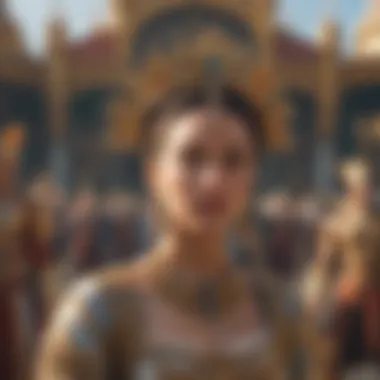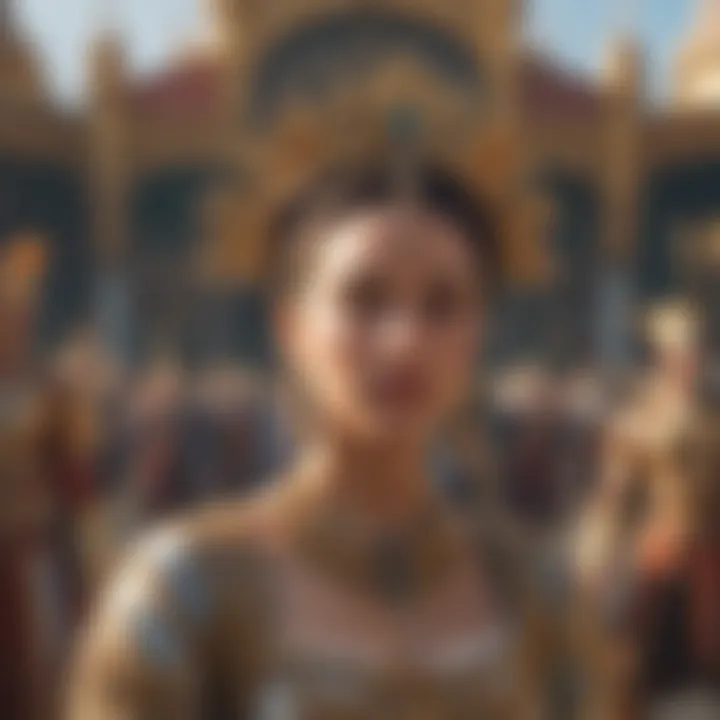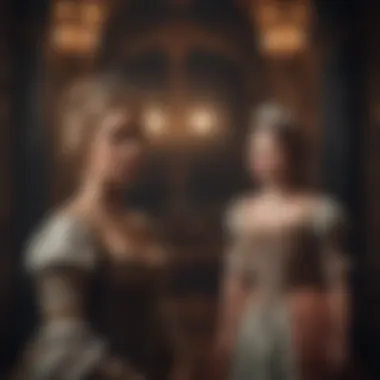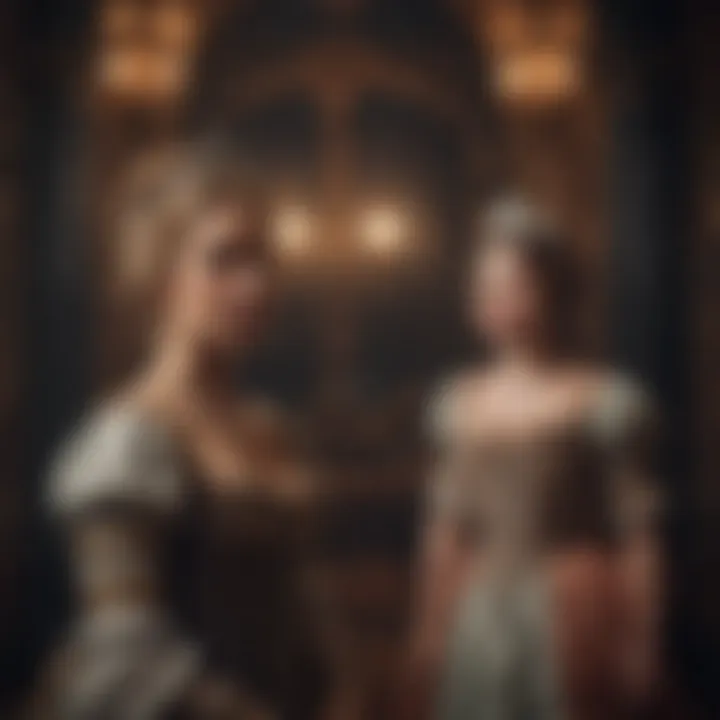Exploring Royal Entertainment: A Cultural Examination


Intro
Royal entertainment holds a significant place in cultural history. From opulent courts to grand theatrical performances, these events shape both art and society. Understanding this connection is vital for anyone interested in music, theater, and the evolution of cultural practices.
Royal courts have often been epicenters of artistic expression. They not only provide the financial backing for various art forms but also serve as the stage for their development. The influence of monarchy on the arts is profound, making it crucial to explore this relationship. Through patronage, kings and queens have shaped artistic trends, which, in turn, reflect societal values and culture.
This article aims to dissect these elements, providing insights into how royal entertainment has evolved over time. We will examine key aspects such as the role of artists, the themes present in performances, and the significance of festivals throughout history.
Artist Profile
Biography and Background
Royal entertainment has been composed of many artists over the centuries. Musicians, playwrights, and dancers come to mind, as they often grace royal courts. One of the notable figures in this realm is William Shakespeare, who has connections to Queen Elizabeth I. His works brought innovative ideas and themes to the stage, influencing not just royal entertainment but also the broader landscape of theater.
Major Influences and Inspirations
The artists influenced by royal patronage often draw inspiration from their environments. They create works that capture the essence of their time, reflecting the political and social climate. For instance, many theatrical works written during the reigns of powerful monarchs featured themes of loyalty and betrayal, which resonated with the audience due to real-life events.
Performance Analysis
Themes and Historical Context
The themes present in royal entertainment often mirror the values and beliefs of the time. For example, during the Renaissance, plays often highlighted the power struggle and moral dilemmas. Similar motifs can be seen in musical compositions from this era.
Key Themes:
- Loyalty: A common theme reflecting the importance of allegiance to the crown.
- Love and Tragedy: Many stories center around personal relationships, often leading to dramatic endings.
- Power and Ambition: These works often question the nature of power and its repercussions on society.
Instrumentation and Composition
Music played an essential role in royal entertainment. For example, orchestral compositions often featured specific instruments like the lute and violin, which were favored in royal courts. This instrumentation was not just for aesthetic purposes, but also served to elevate the status of the performers and the event itself.
An analysis of a notable composition, such as Johann Sebastian Bach's works, reveals how intricate melodies and harmonies captivated audiences. These pieces often shared the stage with theatrical performances, creating a multifaceted experience.
"The amalgamation of music and theater in royal entertainment provides a deeper understanding of the cultural context of the time."
End
In examining royal entertainment, one uncovers the layers of historical significance and cultural relevance. The patronage provided by royal figures has shaped artistic expression profoundly. As we continue to study the impacts of these royal relationships, we can appreciate how they moved beyond the walls of castles, influencing modern entertainment and remaining a crucial aspect of the cultural narrative.
Foreword to Royal Entertainment
Royal entertainment plays a significant role in understanding the cultural narratives of societies through history. It offers a unique lens to analyze how monarchies influence art, performance, and, importantly, how the public engages with these forms of entertainment. Through the celebrations, performances, and artistic expressions patronized by royalty, we can uncover layers of meaning that reflect the values, aspirations, and dynamics of their time.
In this exploration, we will navigate the depths of royal entertainment, considering its definitions, historical precedents, and societal impact. Each subsection unravels a facet of this intricate world. The examination of royal entertainment is not merely an overview; it invites readers to recognize how these acts can serve as reflections of larger societal structures and cultural identities. By immersing ourselves in this topic, we grasp how entertainment has evolved within the context of power.
Understanding royal entertainment allows us to discern its complexities. The relationship between a ruling class and the arts offers insights into broader themes of control, influence, and expression. Additionally, it sheds light on the interconnectedness of various cultural practices, as music, theater, and celebrations often intermingle under the auspices of royal patronage. This narrative isn't just one of extravagance, but also of cultural identity, patronage dynamics, and the aspirations of societies.
Defining Royal Entertainment
Royal entertainment encompasses various forms of artistic expression that are closely associated with monarchy and its courts. This can include a range of activities such as music performances, theatrical plays, grand festivals, and other celebratory events. These forms of entertainment were not simply for enjoyment; they served as instruments of political power and social cohesion. The arts provided a stage—both literal and figurative—where values were communicated, and ideologies were reinforced. Royal entertainment can be seen as a dialogue between the monarchy and the people, where messages of loyalty and grandeur are expressed through artistic vehicles.
Historical Context
The historical relevance of royal entertainment is profound. It traces back to ancient civilizations, where rulers recognized the power of art as a tool for governance and communications. In Ancient Egypt, for example, monuments, rituals, and performances reinforced the divine right of pharaohs. As we move through history, especially into the medieval period, we see royal courts becoming cultural hubs. Kings and queens sponsored troubadours and performers, driving the development of new music forms and dramatic texts.
During the Renaissance, the importance of entertainment surged, with elaborate court performances showcasing the wealth of the monarchy and the talent of the artists. Monarchs like Henry VIII of England not only patronized the arts but also actively participated in them. This period illustrates a turning point where entertainment became both a cultural centerpiece and a display of power.
In summary, the examination of royal entertainment within a historical context reveals its evolving role. From rituals of power to the present day, it continues to serve as a reflection of societal change and cultural identity. This dynamic relationship between monarchy and the arts underscores the deep-seated cultural significance that royal entertainment carries.
The Evolution of Entertainment in Royal Courts
The evolution of entertainment in royal courts serves as a historical lens to understand how cultural expression and monarchical power intertwined over many centuries. As institutions that have heavily influenced social habits and creative standards, royal courts not only dictated personal taste but also preserved and advanced artistic traditions. This section explores the progressive transformation of entertainment within these exclusive realms, examining pivotal historical periods and their unique contributions.


Medieval and Renaissance Influences
During the Medieval period, entertainment often revolved around religious themes, with music and drama serving significant purposes within the context of liturgical celebrations and observances. Traveling minstrels and troubadours were prominent figures, delivering narratives that had both moral and didactic undertones. This art form was essential in court settings, as it fostered social cohesion and provided a vehicle for communication.
As Europe transitioned into the Renaissance, we observe a dramatic shift. The courts became centers of cultural rebirth and intellectual inquiry. Notable figures, such as Lorenzo de’ Medici in Florence, sponsored artists like Botticelli and Michelangelo, thus integrating visual arts with performance and music. This period was vital for establishing opera, which combined multiple art forms, creating spectacles that appealed to diverse audiences. Performance spaces were developed, enhancing the presentation of these lavishly staged shows. The Renaissance is characterized by the exchange of ideas and greater accessibility to the arts, leading to an expanding appreciation among both nobles and commoners alike.
Baroque and Rococo: A New Era
The Baroque period introduced a fresh aesthetic in royal entertainment. From the late 16th to early 18th century, this era embraced grandeur and extravagance. Monarchs like Louis XIV of France utilized elaborate court ballets and operas to enhance their image and stabilize their rule. These performances solidified a connection between the arts and political power, effectively showcasing the opulence of the royal court.
The Rococo period further continued this trend but introduced a softer and more playful aesthetic. Entertainment became increasingly ornate and involved, as seen in lavish masquerade balls and theatrical productions that delighted the elite. The music of composers like Johann Sebastian Bach and Georg Friedrich Handel flourished during this era, echoing the emotive expression that characterized these forms of entertainment. Royal courts transformed into cultural hubs, reflecting the evolving tastes and aspirations of their time.
Influences of the Enlightenment
The Enlightenment brought significant changes to the nature of entertainment at royal courts. This period emphasized reason, intellect, and individualism. Dramatic works began addressing social issues and critiquing authority, thus moving away from mere extravagance to more substantive content. Royal courts still remained important for cultural patronage, but there was a burgeoning interest in civic and public forms of entertainment.
The rise of public concert halls and the emergence of classical music as a widely appreciated genre marked a departure from exclusive court entertainment. Mozart and Haydn, among others, composed works that resonated with both royal audiences and the burgeoning middle class. The establishment of opera houses also ensured that the magic of performance art gradually infiltrated the public sphere.
In summary, the evolution of entertainment in royal courts signifies more than just a historical transition. It embodies the interplay of society, politics, and artistic expression, elucidating how these institutions adapted to cultural demands over time. This journey reflects a complex narrative woven through centuries, positioning royal entertainment as a vital chapter in the history of human creativity and social structure.
Patronage in the Arts
Patronage has played a crucial role in shaping the cultural landscape of royal entertainment. It refers to the financial support given by monarchs and nobility to artists, musicians, and various artistic endeavors. This backing is not simply about funding; it embodies a commitment to enhancing the arts as a reflection of societal values and prestige. Royal patronage has often marked the distinction between thriving artistic movements and stagnation, thus highlighting its significance.
The Role of Monarchy in Artistic Flourishment
Historically, monarchs have acted as primary patrons of the arts, establishing a framework for cultural flourishing. Their influence is evident in the grand projects they commissioned, such as opera houses, concert halls, and extravagant theater productions. Notable figures like Louis XIV of France transformed the arts into a state affair, using theater and music to promote the monarchy's ideology and splendor. This trend was replicated in various cultures, where Royal courts became centers for artistic innovation and creative expression.
The significance of monarchy in artistic flourishing extends beyond mere enjoyment. When royalty invests in the arts, they contribute to a cultural legacy that can influence generations. In many cases, royal endorsement allowed artists to explore new techniques and themes without the fear of economic hardship. For example, composers like Wolfgang Amadeus Mozart thrived under the patronage of nobility, allowing them to produce timeless works that continue to resonate today.
Funding and Support Systems
The funding models for artistic endeavors within royal courts are multifaceted. Funding can come from direct grants, commissions, or the establishment of institutions designed to support artists. Monarchies often set up academies or guilds to nurture talent and secure a continuous flow of artistic innovation. For instance, the Medici family in Florence established a vibrant patronage network that significantly impacted the Renaissance period.
Furthermore, support systems facilitated collaborations between artists across disciplines. By providing a platform for musicians, playwrights, and visual artists, monarchs fostered an ecosystem where diverse forms of art could flourish together. These collaborations led to groundbreaking works that defined their eras. Royal courts, therefore, were not only places of entertainment but also crucibles of artistic movements.
"The heart of art thrives when nurtured; patronage is the lifeline that ensures its pulse."
Key Genres of Royal Entertainment
Royal entertainment encompasses a variety of genres that have historically been paramount in the lives of monarchs and their courts. This section seeks to explain the significance of these genres—music, theater, and festivals—while exploring how they each convey distinct cultural messages. For a comprehensive understanding, it is essential to discuss specific elements within these genres, their benefits, and the considerations regarding their roles in the context of royal culture.
Music: The Soundtrack of Royal Life
Music has always played a central role in royal entertainment. It serves not only as a form of leisure but also as a means of communication and expression. Various styles, from courtly dances to opera arias, reflect the tastes and values of the monarchy.
Royal courts often employed skilled musicians to perform at feasts, ceremonies, and celebrations. The presence of composers like Johann Sebastian Bach and Wolfgang Amadeus Mozart in royal circles illustrates the deep intertwining of music with royal patronage. These musicians crafted works that elevated the status of the monarchy while also advancing their own careers.
Some key aspects of royal music include:
- Ceremonial Functions: Music accompanies various state functions, enhancing the spectacle and grandeur of such events.
- Social Hierarchy: Different genres signify social position, with classical compositions often reserved for higher-stakes occasions.
- Cultural Exchange: Music reflects widespread cultural influences, with styles merging as the monarchy interacts with international courts.
"Music has the unique power to reflect the dynamics of power while also fostering a sense of national identity."
Theater: Staging Royal Narratives
Theater emerges as another critical genre in royal entertainment, serving as both a reflection and a vehicle for the monarchy’s narratives. Historically, plays performed in royal courts told stories that often aligned with the ideals and virtues of the ruling class.
Theatrical performances were not merely entertainment; they were carefully curated events designed to reinforce the monarch's authority. Stories of heroism, valiance, and divine right not only facilitated cultural morality but also shaped public perception of the crown. Important aspects include:
- Political Messaging: Many plays contained hidden or overt commentary on the political climate, often designed to legitimize a ruler’s reign.
- Collaboration with Artists: Monarchs often commissioned works from playwrights, merging artistry with royal patronage to create compelling narratives.
- Influence on Society: Theater allowed for questioning and critiquing societal norms, leading audiences to reflect on their own lives through the lens of the performance.
Festivals and Spectacles
Festivals and spectacles bring vibrancy and community engagement to royal entertainment. These large-scale events unified diverse populations under a shared experience, often glorifying the ruling family while showcasing culture and tradition.


The history of festivals indicates a complex interplay between celebration and propaganda. They offered a platform for the monarchy to project power, grandeur, and benevolence. Noteworthy features include:
- Public Involvement: Many festivals allowed common citizens to partake, enhancing loyalty and strengthening community ties.
- Symbolism: Each festival held unique symbols designed to reinforce royal messages, from seasonal celebrations to commemorative parades.
- Artistic Displays: Festivals often included music, theater, and dance, creating a multi-genre experience that highlighted the creativity of the time.
In summary, the genres of royal entertainment not only served to amuse but also played a vital role in shaping societal values and perceptions of monarchy. Each genre contributes uniquely to the legacy of royal culture, reflecting its complexity and relevance even today.
Influential Monarchs in Entertainment
The realm of entertainment has not developed in isolation; rather, it has evolved alongside the interests and values of ruling figures. Influential monarchs throughout history have played pivotal roles in shaping entertainment forms, fostering a culture of patronage that has propelled the arts. Their direct involvement and support have significantly impacted the nature of music, theater, and festivals, ultimately reflecting their personal tastes and the social dynamics of their time.
Patrons and Composers: A Collaborative History
Throughout history, the relationship between patrons and composers has been essential for artistic creation and evolution. Monarchs have often acted as the primary patrons, providing not only financial support but also a platform for composers to showcase their work. For instance, King Louis XIV of France had a profound influence on the music of his era, employing composers like Jean-Baptiste Lully and later, François Couperin. These composers benefited from the king's lavish court, which served as a vibrant stage for their compositions.
- Monarchical Influence: The preferences and demands of a monarch often dictated the direction of musical trends. When a ruler favored a specific style or genre, composers had to adapt their work to align with these tastes.
- Cultural Collaborations: The collaboration extended beyond mere financial backing. Frequent interactions between composers and monarchs could lead to the merging of ideas, fostering innovative works that echoed the personalities of both.
- Legacy of Works: Many compositions from history are closely tied to the patronage of specific kings and queens. Understanding this background adds depth to the appreciation of these pieces.
The relationship is, therefore, not only one of support but also mutual influence, creating a rich tapestry of artistic expression recorded in history.
Impact of Monarchs on Performing Arts
Monarchs have exerted substantial influence over various performing arts, often using these mediums to project power and legitimacy. Their direct engagement with the arts enabled them to control narratives, establish cultural norms, and promote national identities through performances.
- Royal Edicts: Edicts issued by monarchs often regulated the performance of plays, choosing the subjects deemed suitable for public consumption. This control could either uplift or restrict artistic freedom, depending on the era and ruler.
- Extravagant Productions: The scale of royal events shaped the standards for public performances. Grand displays became a way for monarchs to demonstrate wealth and culture, encouraging a rise in theatrical productions and musical extravaganzas.
- Cultural Patrimony: Royal support has often led to lasting legacies in the performing arts, resulting in unique art forms associated with particular dynasties. The continuation of these traditions can be seen in modern artistic expressions.
"The interplay between ruling powers and art is a silent testament to a society’s values, aspirations, and cultural heritage."
Royal Performances in Modern Context
The concept of royal performances in the modern context holds a distinct and evolving significance. These events often serve as a bridge between historical traditions and contemporary expressions. They showcase how the legacy of royal entertainment adapts to current societal norms while retaining a sense of grandeur and cultural importance. Exploring this subject allows us to comprehend the role of monarchy in modern entertainment and the ways it shapes public perception.
Current Trends in Royal Entertainment
In recent years, royal entertainment has witnessed diverse trends influenced by societal shifts and technological advancements. One notable trend is the incorporation of inclusivity. Modern royal events strive to reflect broader cultural narratives, embracing various artistic expressions and voices. This evolution is essential as societies become more interconnected, and cultural dialogues expand.
Furthermore, diversity in performances, featuring artists from various backgrounds, has become popular. Events such as royal concerts and charity galas now prioritize showcasing multicultural talent. These trends not only highlight societal changes but also enhance the appeal of royal performances to younger audiences.
"The evolution of royal performances is crucial in retaining relevance within modern society, aligning traditional practices with contemporary values."
Moreover, the format of royal performances is shifting. Traditional formats are increasingly blended with modern entertainment styles, resulting in unique experiences. For example, incorporating elements of pop music or contemporary dance alongside classical presentations helps attract a broader audience. This approach maintains the essence of royal entertainment while capturing the spirit of modernity.
The Role of Technology
Technology plays a pivotal role in redefining how royal performances are experienced today. Online streaming has become a commonplace platform for audiences worldwide to access royal events. This development democratizes access, allowing people from different regions to engage with royal culture. Virtual reality is also emerging as a tool to enhance audience interaction with royal performances, creating immersive experiences.
Social media platforms allow for real-time sharing and commentary on royal events, shaping public dialogue and perception. Royal families often use these platforms to promote their engagements and initiatives, further intertwining the modern royal image with digital presence.
In summary, royal performances in the modern context significantly reflect evolving societal values. Current trends emphasize inclusivity and diversity while integrating technology to enhance audience engagement. This fusion of tradition and modernity ensures that royal entertainment remains relevant and impactful in a rapidly changing world.
Cultural Significance of Royal Entertainment
Royal entertainment has long served as a mirror reflecting the cultural and social dynamics of society. Throughout history, the ways in which monarchy engages in entertainment reveal significant insights about prevailing societal values, power structures, and artistic innovation. Understanding these aspects is essential in grasping how royal entertainment shapes culture and influences the collective consciousness of a nation.
Reflection of Societal Values
Royal entertainment often embodies the values and beliefs of the society it represents. It serves as a platform for both celebration and critique. For instance, during periods of prosperity, royal courts have hosted extravagant performances that emphasize wealth and power. Conversely, in times of crisis, such forms of entertainment might shift to focus on themes of unity, resilience, and moral values.
In addition, royal events such as coronations or state banquets showcase traditional customs and honors that have been preserved through generations. These activities not only underscore the importance of heritage but also highlight the monarchy's role in maintaining a narrative that unites citizens under shared symbols and rituals. For many, these performances provide a sense of legitimacy and continuity within the changing tides of political and social landscapes.
Moreover, royal entertainment can also reflect the evolution of artistic expressions influenced by societal changes. As music styles and theatrical traditions develop, they often mirror the public sentiment on issues like equality, justice, and progress. For example, the rise of avant-garde performances in royal contexts during the Enlightenment ushered in new ways of thinking about individual rights and human dignity.
Entertainment as a Tool of Propaganda
Monarchs have used entertainment as a means of shaping public perception and reinforcing their authority. Historically, grand spectacles have served dual purposes: to entertain and to send a political message. Such events foster loyalty among subjects while simultaneously displaying the power and influence of royalty, often blurring the line between celebration and propaganda.


Royal feasts, performances, and festivals often emphasize the monarch's benevolence and virtue. These occasions highlight the royal family's contributions to the cultural life of a nation, tailored to present an idealized image that encourages public admiration and allegiance. They also provide an avenue through which monarchs can communicate their ideologies and policies in a more palatable format.
For example, during the reign of Louis XIV in France, the opulence of his court at Versailles was not simply for display. It was a deliberate strategy to consolidate power and control through a captivating cultural experience. The arts flourished under his patronage, but so did the idea of absolute monarchy.
In contemporary contexts, the role of entertainment in royal propaganda remains relevant. Events streamed globally can influence international perception, acting as tools for soft diplomacy. Royal appearances, performances, and charitable events are strategically orchestrated to enhance their image. This ongoing interplay between entertainment and propaganda allows modern monarchies to maintain relevance in an increasingly questioning and skeptical world.
In summary, the cultural significance of royal entertainment is deeply intertwined with how societies express their identity and values. It serves not only as a form of engagement but also as a powerful means to shape narratives that resonate within historical and modern contexts.
Comparative Analysis of Global Practices
The examination of royal entertainment across different cultures provides insights into how societal values and norms shape artistic expressions. Understanding global practices offers a lens to compare how monarchies influence entertainment in unique ways. It highlights the various elements of culture, religion, and tradition that play a role in shaping royal entertainment. Furthermore, dissecting these elements sheds light on the benefits and considerations of royal patronage in varying contexts.
Royal Entertainment in Different Cultures
Royal entertainment manifests itself in distinct forms around the world. Each culture has its unique practices that reflect its historical contexts and societal values. For instance, in Thailand, the Royal Barge Procession features ornate boats and traditional music, displaying the nation's heritage and devotion to the monarchy.
In France, the opulence of the Ballet de Cour during the reign of Louis XIV emphasizes elaborate choreography and costuming as an expression of royal authority and cultural prestige. Similarly, India's grand festivals, such as Diwali, often include royal patronage that showcases traditional music, dance, and theater, reaffirming the connection between the royal family and cultural identity.
Shared Themes and Distinct Differences
While examining these global practices, certain themes emerge that highlight both commonalities and disparities. Across cultures, royal entertainment often serves several purposes:
- Cultural Reflection: It reflects the society's values, beliefs, and history.
- Political Endorsement: Many performances act as a form of soft power, solidifying the monarchy's position among the populace.
- Artistic Patronage: Monarchs are frequently pivotal in funding and advancing the arts.
However, distinct differences are notable as well. For example, Western monarchies tend to focus on formalized artistic expressions like opera and theater, while Asian cultures may emphasize participatory and communal aspects within festivals that engage broader audiences.
"The nuances of royal entertainment across cultures reveal a deep connection between artistry and societal values, showing us how paramount royal influence can craft cultural identity."
The Future of Royal Entertainment
The landscape of royal entertainment is facing a pivotal shift, influenced by societal changes and technological advancements. As we look ahead, we can identify emerging trends that may redefine the ways in which royal events are conceived, produced, and experienced. Understanding these future directions is essential for recognizing the ongoing significance of royal entertainment in modern culture.
Evolving Perceptions of Monarchy
The monarchy is often seen through a lens of tradition and heritage. However, today's societal values are challenging these perceptions. The younger generations have different expectations of transparency, inclusivity, and engagement from their royal institutions.
- The Shift in Public Expectation
Royal families now have to navigate a more discerning public. Social media platforms provide a space for dialogue about their activities, requiring them to showcase authenticity beyond mere pageantry. - Engagement with Contemporary Issues
Today’s royal figures often engage with contemporary issues such as climate change, social justice, and mental health. This engagement means that royal events may evolve from traditional forms to more relevant expressions that resonate with current societal beliefs. - Experimentation in Formats
Future royal entertainment might embrace less formal formats, integrating popular culture with royal traditions. Collaborations with artists and musicians from diverse backgrounds could create modern interpretations of royal events.
This evolution in the public perception of monarchy not only reflects societal changes but also enhances the royal family’s relevance in today's world.
Sustainability in Entertainment Practices
As awareness of environmental issues rises, royal entertainment is also navigating the path toward sustainability. This transition is multi-faceted, with implications for production, event logistics, and audience interaction.
- Eco-friendly Practices
Future royal events are likely to adopt eco-friendly measures, minimizing waste and utilizing sustainable products. Such practices could involve outdoor venues which reduce energy consumption, or digital invitations that replace paper. - Local Engagement
Royal families can enhance their impact by showcasing local artists and craftsmen. By doing so, they contribute to local economies and promote sustainable practices within their communities. - Educational Initiatives
Incorporating educational components into royal events can raise awareness about sustainability. Workshops or talks on environmental stewardship during festivals can engage the audience while aligning with global movements.
As the monarchy adapts its entertainment practices to be more sustainable, it can play a significant role in setting a precedent for other institutions to follow.
The future of royal entertainment holds promise as it evolves alongside societal expectations and environmental responsibilities. The intertwining of royal heritage with modern values may indeed shape a new chapter in this cultural exploration.
The End: The Lasting Impact of Royal Entertainment
The exploration of royal entertainment reveals a rich tapestry woven from history, culture, and artistic expression. Its significance extends far beyond mere spectacle; it provides insight into the values and aspirations of societies throughout time. Understanding this impact is crucial, as it showcases how performances have historically functioned not only as entertainment but also as vital components of statecraft, social cohesion, and cultural identity.
Royal entertainment has shaped the arts, influencing composers, playwrights, and artists from the medieval period to modern times. Its legacy can be seen in the celebrated works of historical figures like Johann Sebastian Bach, who received patronage from rulers, or William Shakespeare, who performed for royalty. This relationship between monarchy and the arts fostered an environment where creativity could flourish, leading to an enduring impact on music and theater.
The intricate dynamics of royal entertainment serve multiple functions: it elevates public morale, reinforces social hierarchies, and communicates political messages. Festivals, ballets, operas, and orchestral performances were often designed to reflect the power and legitimacy of the monarchy. This instrumental use of entertainment culminated in propaganda that not only showcased royal prowess but also engaged the populace's spirit, creating a duality where the audience was both captivated and controlled.
"The arts provide a mirror in which society can reflect on itself; royal entertainment amplifies this reflection on a grand scale."
In modern contexts, these forms have evolved but still retain elements of their historical roots. Contemporary royals continue to engage in patronage and support for the arts, underscoring the relevance of their role in today's cultural landscapes. Moreover, as society shifts towards new technologies and social media, royal entertainment adapts, presenting opportunities to reach wider audiences. The relationship between royal families and popular culture remains significant, paving the way for future developments in music and performing arts, thus ensuring their lasting importance.
Enduring Legacy and Historical Relevance
The enduring legacy of royal entertainment is characterized by its capacity to integrate into the fabric of society. Throughout history, these events have not only entertained but also educated and inspired. The influence of royal courts established artistic standards that many still strive to achieve today.
Key aspects of this legacy include:
- Cultural Preservation: Royal entertainment has helped to sustain and popularize traditional forms of art. By sponsoring festivals and theatrical performances, monarchs have safeguarded cultural practices for future generations.
- Artistic Innovation: The wealth and resources available to royal patrons led to remarkable artistic developments. Many composers and playwrights took creative risks under the auspices of the monarchy, resulting in breakthroughs that still resonate in today’s arts.
- Historical Documentation: Events staged in royal courts function as historical documents, allowing future generations to glimpse the values, fashion, and narratives of their predecessors. This archival role places entertainment at the intersection of culture and history.
In summary, royal entertainment holds a pivotal role throughout history and into the present. Its effects continue to ripple across cultures, as artistic practices evolve while still acknowledging their origins in royal patronage.







